![]()
![]()
![]()
Use LEFT and RIGHT arrow keys to navigate between flashcards;
Use UP and DOWN arrow keys to flip the card;
H to show hint;
A reads text to speech;
77 Cards in this Set
- Front
- Back
- 3rd side (hint)
|
(Mid) Sagittal Plane |
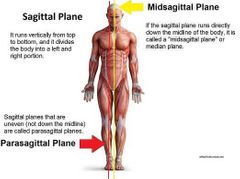
Divides the body into right and left parts.
Vertical line which divides the body into a left section and a right section. |
|
|
|
Coronal Plane / Frontal Plane |

Vertical line which divides the body into a front (anterior) section and back (posterior) section.
|
|
|
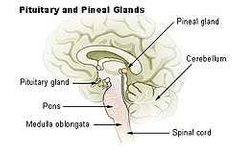
Which hormone is produced by the pineal gland? |
Melatonin |
|
|
|
In which of the following muscle types are filaments arranges in a disorderly manner? |
Smooth Muscle |
|
|
|
Transverse Plane |
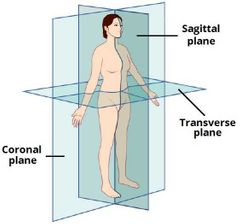
Horizontal line which divides the body into an upper (superior) section and a lower (inferior) section. |
|
|
|
In the development of genetic traits, one gene must match to one _______ for the traits to develop correctly. A. Codon B. Protein C. Amino Acid D. Chromosome |
Protein |
|
|
|
Dorsal Cavity of Body Has. A. Heart B. Testes C. Stomach D. Spine |
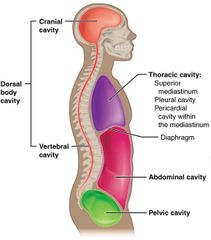
-Spine
-Includes cranial and vertebrial cavities. -Contains the primary organs of the nervous system, including the brain and spinal cord. |
|
|
|
Thoracic Cavity |

Ventral (anterior) body chamber that contains the pericardial cavity (the heart) and the pleural cavity (the lungs). |
|
|
|
Ventral means. |
Anterior or front. |
|
|
|
Dorsal meaning. |
Posterior or towards the back. |
|
|
|
Abdominoplevic Cavity contains. |
The ventral body chamber that contains the abdominal cavity (primarily digestive system) and the pelvic cavity (primarily reproductive system). |
|
|
|
Which of the following best describes the careful ordering of molecules within solids that have a fixed shape? A. Physical bonding B. Polar molecules C. Metalloid structure D. Crystalline order |
Crystalline order |
|
|
|
Which of the following describes the transport network that is responsible for the transference of proteins throughout a cell? A. Golgi apparatus B. Endoplasmic reticulum C. Mitochondria D. Nucleolus |
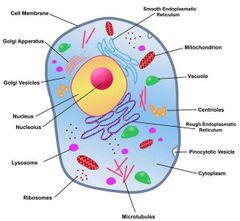
Endoplasmic reticulum |
|
|
|
Mitosis Stages |
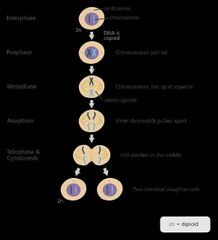
https://www.yourgenome.org/facts/what-is-mitosis
|
|
|
|
Which of the following is true about normal lung anatomy? |
The right lung has 3 lobes. Left lung has 2 lobes. |
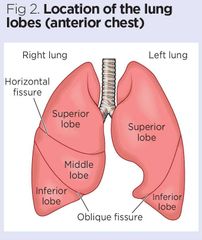
Hint |
|
|
A(n) ______ is the physical and visible expression of genetic trait. A. Phenotype B. Allele C. Gamete D. Genotype |
Phenotype: physical expression such as hair color |
|
|
|
Genotype is |
Is the basic genetic code. |
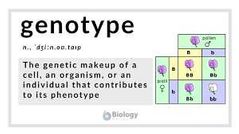
|
|
|
Lateral meaning. |
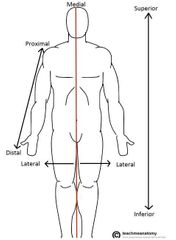
Of, at, toward, or from the side or sides |
|
|
|
Cranial, Caudal, Anterior, Posterior, Superior, Inferior, Proximal, Distal, Lateral, Medial (Study Image) |
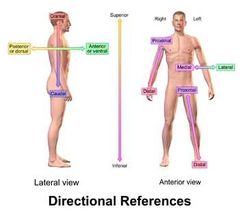
|
|
|
|
One of the roles of RNA |
Sending messages about the correct sequence of proteins in DNA. |
|
|
|
What are 2 types of measurements important in science? |
Quantitative and Qualitative |
|
|
|
Neurons of Br |
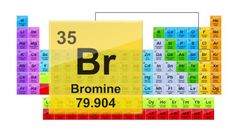
Atomic Mass - Atomic # = Neurons 79.0 - 35 = 44.9 Neurons |
|
|
|
Protons of Zn |

The Atomic # = the # of Protons (30) |
|
|
|
Electrons of Zn (Zinc) |
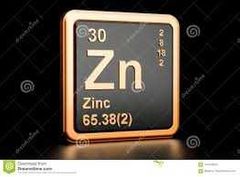
# of Electrons is the same as the atomic #, so 30 electrons |
|
|
|
What is the name of the process in the lungs by which oxygen is transported from the air to the blood? |
Diffusion |
|
|
|
Which gland is responsible for the regulation of calcium levels? |
Parathyroid gland. |
|
|
|
Which section of digestive system is responsible for water reabsorption? |
The Large Intestine. |
|
|
|
When are the parasympathetic nerves active within the nervous system? |
During resting or sleeping. |
|
|
|
The sympathetic nerves are active when the individual experiences a..... |
Strong emotion such as fear, or excitement. |
|
|
|
Blood flow order through the heart |
https://www.sciencelearn.org.nz/videos/1608-blood-flow-through-the-heart
Blood enters the heart through two large veins – the posterior (inferior) and the anterior (superior) vena cava – carrying deoxygenated blood from the body into the right atrium.Blood flows from the right atrium into the right ventricle through the tricuspid valve. When the ventricle is full, the tricuspid valve shuts to prevent blood flowing backwards into the atrium.Blood leaves the heart through the pulmonic valve into the pulmonary artery and flows to the lungs.The pulmonary vein carries oxygen-rich blood from the lungs into the left atrium.Blood flows from the left atrium into the left ventricle through the open mitral valve. When the ventricle is full, the mitral valve shuts to prevent blood from flowing backwards into the atrium.Blood leaves the heart through the aortic valve into the aorta and to the rest of the body. |
|
|
|
The respiratory system ____ oxygen and ____ carbon dioxide. A. Inhales; exhales B. Deliver; expels C. Creates; absorbs D. Exhales; inhales |
Delivers ; Expels |
|
|
|
Which of the following term means close to the trunk of the body? A. Superficial B. Sagittal C. Proximal D. Distal |
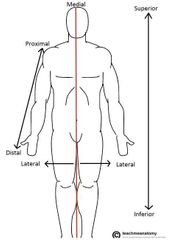
Proximal |
|
|
|
Sagittal means.... |
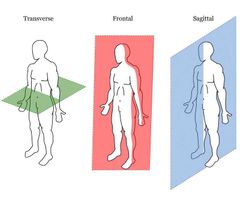
|
|
|
|
What is the process by which simple cells become highly specialized cells? A. Cellular complication B. Cellular specialization C. Cellular differentiation D. Cellular modification |
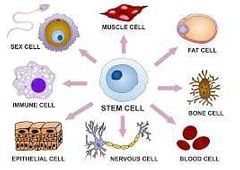
Cellular differentiation Cellular differentiation is the process in which a cell changes from one cell type to another. Usually, the cell changes to a more specialized type. |
|
|
|
How does meiosis differ from mitosis? |
Meiosis produces cells that are genetically different. Mitosis produces cells that are genetically identical. |
|
|
|
Which of the followong is an example of a tissue? A. Chloroplast B. Liver C. Mammal D. Hamstring |
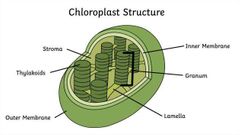
Chloroplast |
|
|
|
Name the valve that allows blood flow from the right atria into the right ventricle? A. Tricuspid valve B. Pulmonic valve C. Mitral valve D. Aortic valve |
Tricuspid valve |

|
|
|
What are substances that stimulate adaptive immunity called? A. Peptides B. Phagocytes C. Prions D. Platelets |
Phagocytes |
|
|
|
Which has the least amount of sweat glands? A. Back B. Palms C. Axilla D. Forehead |
Back |
|
|
|
What type of chemical bond connects the oxygen and hydrogen atoms in a molecule of water? A. Static bond B. Aquatic bond C. Ionic bond D. Covalent bond |
Covalent bond |
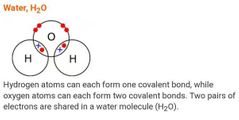
|
|
|
What do T cells do? |
They play a role in the immune response. |
|
|
|
What type of bond is formed when electrons are transferred between atoms? |
Ionic bond |
|
|
|
What is the primary function of antibodies? |
To facilitate the breakdown of antigens. |
|
|
|
What is the normal blood flow through the heart? |
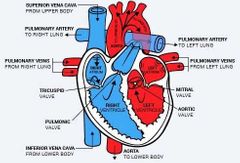
Right atria, right ventricle, lungs, left atria, left ventricle, body |
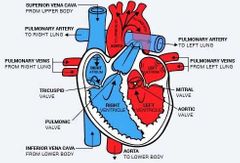
|
|
|
Primary function of Bartholin's glands is.... |
Provide lubrication for the vagina. |
|
|
|
Which nervous system controls voluntary motor movement? A. Parasympathetic B. Sympathetic C. Autonomic D. Somatic |
Somatic |
|
|
|
How many different types of tissue are there in the human body? |
4 Epithelial, connective, muscle, and nerve tissue. Epithelial tissue: Lines the internal and external surfaces of the body. It is like a sheet, consisting of squamous, cuboidal, and columnar cells. They can expand and contract, like on the inner lining of the bladder. Connective tissue: Provides the structure of the body, as well as the links between various body parts. Tendons, ligaments, Cartilage, and bone are all examples of connective tissue. Muscle tissue: Is composed of tiny fibers, which contract to move the skeleton. There are 3 Types of muscle tissue: smooth, cardiac, and skeletal. Nerve tissue: Makes up the nervous system; it is composed of nerve cells, nerve fibers, neuroglia, and dendrites. |
|
|
|
Which of the following bone types is embedded in tendons? Long bones Sesamoid bones Flat bones Vertical bones |
Sesamoid bones. |
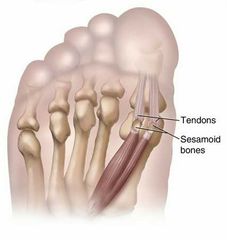
|
|
|
Which is not a product of respiration? |
Glucose |
|
|
|
Of the following, the blood vessel containing the least-oxygenated blood is... Aorta Vena cava Pulmonary artery Capillaries |
Pulmonary artery. |
|
|
|
Which layer of the heart contains striated muscle fibers for contraction of the heart? |
Myocardium Myo- means muscle - The myocardium is the layer of the heart that contains the muscle fibers responsible for contraction. The Endocardium and epicardium are the inner and outer layers of the heart wall. The pericardium is the sac in which the heart sits inside the chest cavity. |
|
|
|
Which blood vessel carries oxygenated blood back to the heart? |
Pulmonary vein. - This is a tricky question, most of the time, veins carry deoxygenated blood and arteries carry oxygenated blood. However in this case, the pulmonary veins carry oxygenated blood from the lungs to the heart and the pulmonary arteries carry the deoxygenated blood from the heart to the lungs. |
|
|
|
Is dependent variable versus independent variable. |
The independent variable is the variable that is changed in the experiment in order to determine its effect on the dependent variable or the outcome of the experiment. The dependent variable results from the experimenter making only one change to an experiment that can be repeated with the same results. |
|
|
|
Mitochondria is the cells.... |
Power house, provides energy for cellular functions |
|
|
|
What function do ribosomes serve within the cell? |
Ribosomes aid and protein synthesis. - Ribosomes are organelles that help synthesize proteins within the cell. -Celia and flagella are the responsible for cell movement. -The cell membrane helps the cell maintaine its shape and protects from the environment. -Lysosomes have digestive enzymes. |
|
|
|
How do DNA and RNA function together as part of the human genome? |
RNA carries genetic information from DNA to the cell cytoplasm. - DNA is a primary Carrier of genetic information in most cells. RNA serves as a messenger that transmits genetic information from DNA to the cytoplasm of the cell. |
|
|
|
Process of food digestion... |
Food enters the digestive system through the mouth and proceeds down to the stomach after mastication by the teeth. Once in the stomach, enzymes are secreted that begin to Digest the specific substances and food (proteins, carbohydrates, etc). Next, the food passes through the small intestine where the nutrients are absorbed And then into the large intestine where extra water is absorbed. |
|
|
|
What process should the DNA within a cell undergo before cell replication? |
The DNA should replicate so that the daughter cells have the same amount of DNA material after cell division. - After cell division, the daughter cells should be exact copies of the parent cells. Therefore, the DNA should replicate, or make an exact copy of itself, so that each daughter cell will have the full amount of DNA. |
|
|
|
Which statement most accurately compares and contrasts the structure of DNA and RNA. |
Both DNA and RNA have 4 nucleotide bases. 3 of the bases are the same but the 4th base is thymine in DNA and uracil in RNA. -Both DNA and RNA are made up of 4 nucleotide bases. Both DNA and RNA contain cytosine, guanine, and adenine. However, DNA contains thymine and RNA contains uracil. |
|
|
|
Which of the following characteristics is part of a person's genotype? A. Brown eyes that appear Hazel in the sunlight B. CFTR genes that causes cyctic fibrosis C. Black hair that grows rapidly D. Being a fast runner |
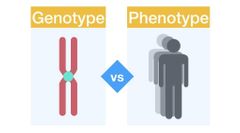
CFTR genes thats causes cyctic fibrosis
The genotype describes a person's genetic makeup.
The phenotype describes a person's observable characteristics. |
|
|
|
Interstitial fluid |
Interstitial fluid is found in the tissues around cells. Intracellular fluid is found within the cells. Fluid in the ventricles of the brain and down into the spinal cord as called cerebropinal fluid. Cerebralspinal fluid bathes the sensitive tissues in a fluid that helps to protect them. Blood and lymph are the fluids that carry nutrients, oxygen, waste, and lymph material throughout the body. |
|
|
|
A Catalyst does what? |
Is a catalyst increases the rate of a chemical reaction without becoming part of the net reaction. |
|
|
|
Which structure controls the hormone secreted by the pituitary gland? |
Hypothalamus |
|
|
|
Where does gas exchange occur in the human body? |
Alveoli Gas exchange occurs in the alveoli, the minute air sacs on the interior of the lungs of the lungs. The bronchi are a large cartilage based tubes of air; they extend from the end of the trachea into the lungs, where they branch apart. The larynx, which houses the vocal chords, is positioned between the trachea and the pharynx, it is involved in swallowing, breathing, and speaking. The pharynx extends from the nose to the uppermost portions of the trachea and esophagus. In order to enter these two structures, air and other matter must pass through the pharynx. |
|
|
|
What lab equipment would most likely be used to measure a liquid solution? Flask Triple beam balance Graduated cylinder Test tube |
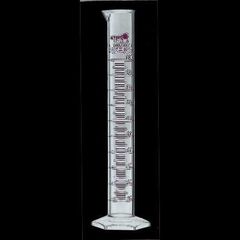
Graduated cylinder A triple beam balance measures the weight of an object in grams. A flask and a test tube are used to contain a liquid while being heated or stored. |

|
|
|
Which of the following best describes the structures found underneath each rib in descending order? |

Vein, artery, nerve
Is the neuro vascular structure found underneath each rib and descending order is the vein, artery, nerve. |
|
|
|
The spleens job is to... |
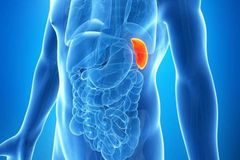
Filter the blood by removing dead or dying red blood cells as well as microorganisms. |
|
|
|
Which of the following is a protein that interferes with virus production? Lysozyme Prion Interferon Keratin |
Interferon Interferons are members of a larger class of proteins called cytokines. |
|
|
|
Hypothalamus |
Is a tiny gland at the base of the brain. It helps regulate temperature, sleep, emotions , sexual function and behavior. During puberty it secretes hormones that stimulate the gonads which initiate sexual development. |
|
|
|
Which of the heart chambers is the most muscular? |
Left ventricle. When it contracts , it pushes blood out to the organs and extremities of the body. |
|
|
|
Which part of the brain interprets sensory information? Cerebrum Hindbrain Cerebellum Medulla oblagata |
Cerebrum |
|
|
|
Cerebrum |
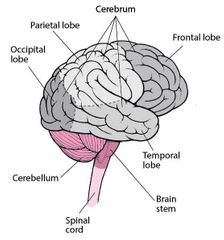
Part of the brain that interprets sensory information. It is the largest part of the brain. It is divided into 2 hemispheres, connected by a thin band of tissue called the corpus callosum. |
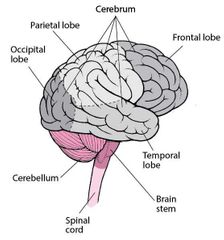
|
|
|
Cerebellum |
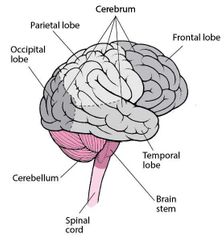
Is positioned at the back of the head, between the brain stem and the cerebrum. Controls both voluntary and involuntary movements. |
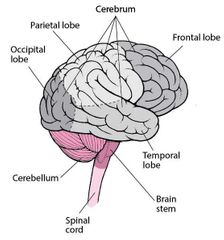
|
|
|
Medulla Oblongata |
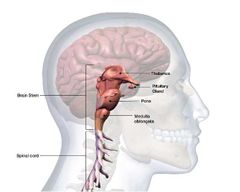
Forms the base of the brain. Responsible for blood flow and breathing, among other things. |
|
|
|
Which component of the nervous system is responsible for lowering the heart rate? |
The parasympathetic nervous system. It slows the HR, dilates the blood vessels, and increases the secretions of the digestive system. |
|
|
|
Parasympathetic nervous system |
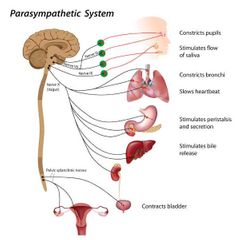
The parasympathetic nervous system predominates in quiet “rest and digest” conditions. Associated with returning the body to routine, day-to-day operations. The part of the involuntary nervous system that serves to slow the heart rate, increase intestinal and glandular activity, and relax the sphincter muscles. |
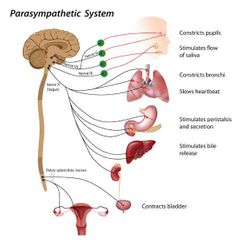
|
|
|
Sympathetic Nervous System |
Fight or flight: This response is characterized by the release of large quantities of epinephrine from the adrenal gland, an increase in heart rate, an increase in cardiac output, skeletal muscle vasodilation, cutaneous and gastrointestinal vasoconstriction, pupillary dilation, bronchial dilation, and piloerection. The overall effect is to prepare the individual for imminent danger
Increases heart rate, blood pressure, breathing rate, and pupil size. |
|

